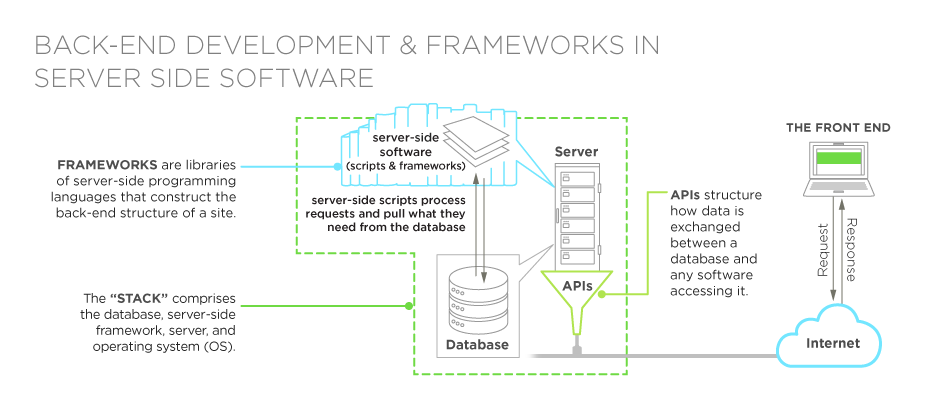Your web site or web application is a pile of layers, structure, design, and content, and functionality. The technology and programming that manage the site, the part of the site that users do not see, is called back-end. It contains a server, database and applications on the server side and represents the functionality in the background, the brain on the site. This is the eco system of the database administrator and the back-end programmer. Let’s look at the role of back-end developers: their responsibilities, the environment they work for, the technologies they use, and all the back-end skills.
What is Back-Ennd: Adding a function to a form
Vack-end is the machine that runs the site. The user does not see it, nor is it directly interacting with it as with the technology on the client side, but it always works in the background, while providing you with the functionality, desktop experience and information from the database directly in the browser.
BASICS OF BACK-END DEVELOPMENT

The back-end code adds a usable value to everything that the front-end designer creates.
Back-end is a combination of database and server-side language software that runs on web services, cloud servers or a hybrid combination of both. Setting up a network server can vary, by splitting the work from the server side to several machines (for example, a dedicated server for hosting a database).
This application from the server side is in direct interaction with the API database, which extracts, stores and changes data.
The data is returned and converted to the front-end code with which the user is then interacting: filling out a form, creating a profile, shopping on the Internet, etc.
In fact, everything you see on a site is made possible by the back-end code that exists on the server and is managed by the server.
BACK-END DEVELOPER MACHINE
Back-end developers create and maintain the entire back-end feature that we described above. They take the finished front-end code and give it operational functionality, for example. allowing values in a drop-down list by creating an infrastructure that extracts the values from the database.
Their other obligations would include
Creating a database, integration and management, eg. MySQL, SQLite, PostgreSQL, and MongoDB. SQLite is easy and fast, making it a very popular alternative to the larger MySQL.
Use back-end work-frames to build software from a server side, such as Express.js
Web server technologies, such as J2EE, Apache, Nginx (popular for static content, like images, HTML or CSS files), and IIS
Integration with cloud services, e.g. public providers like Amazon Web Services, or private cloud environments.
Program languages from a server side such as Python, Perl, PHP, Ruby, and JavaScript, when implemented with a server-side development environment, Node.js
Operating Systems: Linux and Unix, MacOS X, Windows Server
Development of CMS (Content Management System), Hanging and Maintenance
API integration
Security Prevention and Hacking Prevention
Reports, generating analytics and statistics, such as system reports for server load, number of visitors, visitor geography, etc.
Backup and technologies for recovering files on the web site and the database.
SERVER PROGRAM LANGUAGES AND WORKING FRAMEWORK
Back-end developers use a range of programming languages and work frames in their work, according to their work style and specific site requirements. It can also work with a language in a software kit. Popular back-end technologies are:
Ruby: Great for building a complicated logic on the database page. Ruby brings together back-end and database functionality that PHP and SQL can offer you as a pair. Excellent for startup companies, easy to maintain and suitable for the needs of high traffic. It looks for the Ruby on Rails framework, which has huge libraries with code for easy development. Sites in Ruby: Hulu and Twitter
Java: As a subset of the C language, Java comes with a huge eco system of additional software components. Basically, Java is a variation of C ++ with a lighter curve of learning. Its platform is independent thanks to the Java Virtual Machine. “Compile once, let it go anywhere” is their motto. Great for great applications, heavy traffic sites and Android apps.
The work frames are: Struts and Hibernate
C #: C # is an improved version of the second generation of C language. C # is an object-oriented version, which is specially developed by Microsoft for the .NET Framework.
Python: With less rows of code, Python is a quick language, which perfectly suits you when you want to quickly start using it. The emphasis is placed on its readability and simplicity, so it is great for beginners. It is the oldest of all scripting languages. It’s powerful, and works great in object-oriented designs. Sites made with Python: YouTube, Google
Work Frames: Django, Flask, and Pyramid
PHP: The most popular language on the server side, PHP is designed to extract and edit information in the database. It is usually grouped with databases written in SQL language. PHP is unique because it is built for the web, and is not suited to it. It is the most widely used language and has a number of modern working frameworks.
Perl: With 27 years of revisions and changes behind, Perl 5 is an interpreted high-level language for database integration with Oracle, Sybase, MySQL, and more. Works on more than 100 platforms and, like Python and Ruby, is object-oriented and open-source.
Erlang: This is a general-purpose programming language that is competitive, ie parallel, which means that multiple processes can be played at the same time at the language level, without the need for support from an external library. It is used in LYME and LYCE sets, a large number of CMS and databases, GitHub, and the Goldman Sachs platform, supporting high-frequency requirements.
Node.js: Part of the MEAN set managed by JavaScript, it allows the front-end JavaScript language to be used in applications from the server side with the Express.js worksheet.
BACK-END ROOMS SOFTWARE
Depending on which kit you choose, a back-end developer will need to know more than one component.
What is a software kit? “Kit” is a set of software for various aspects of your site in the back end, combined for their compatibility and functionality, with the only purpose to facilitate development. The components include an operating system, a web server, a database, and a scripting language from a server side. You are not limited to the components in the kit because they are highly adjustable and can be changed according to your needs.
TWO MOST CLOSED ROOMS
- LAMP: Linux / Apache / MySQL / PHP
LAMP consists of free, open-source software components that are good for dynamic web sites and applications. This is the most traditional set, with several variants for different operating system options, servers and databases. In the LAMP suite, PHP can be replaced with Python and Perl.
LAMP Advantages: Flexible, adaptable, easy to develop, secure. Additionally, it comes with a huge community of support because it is open source.
- MEAN: MongoDB / Express.js / AngularJS / Node.js
MEAN is a JavaScript-managed replacement for the traditional LAMP kit. It’s great for businesses that require agility and scalability. Offers flexibility to the MongoDB database based on documents, and has many options for building applications from one or more pages. By using JavaScript on the front and back end, the developers working on the client side will easily understand the server code, which leads to greater productivity of the team.
Benefits of MEAN: one language is used, supports a MVC model, uses JSON for data transfer, provides access to the JavaScript modular library on Node.js, and the Express.js work frame. And he comes with a huge community of support because it is open source.





















